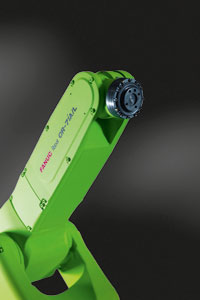
Posted to News on 17th May 2017, 00:00
A simple guide to robot safety
As adoption of robots within UK industrial sectors picks up, Andrew Armstrong of Fanuc looks at how to ensure operational safety.

If used without care, robots can be dangerous to humans. Back in 1961 when General Motors introduced the first industrial robot to its production line, humans were at high risk inside a robot’s work zone. Since that time, robot manufacturers have spent enormous effort and money to produce models with the best possible safety levels.
As robots have become more refined, and applied across more industry sectors, mainly for heavy work, devices are used to monitor a robot’s surroundings, such as vision and force sensors that allow robots to see and feel what is around them. Using smart synthetic skins, scientists are even looking to endow future robots with a human-like sense of touch.
In recent years, collaborative robots (cobots) have emerged. In contrast to traditional robots, which cannot operate in an operator-occupied workspace without safety fencing, these cage-free robots can work side by side with humans on shared or separate tasks. Although collaborative robots do not eliminate the need for workplace risk assessments, the increased adoption of peripheral safety devices is enabling robots and humans to work in close proximity of each other, eradicating the fear of interrupting production or worse, an accident.
Cobots are equipped with force sensing to limit their power and force: in any situation they can feel or detect an abnormal force and stop their motion immediately. Although they still cannot avoid a crash, cobots can reduce its impact and avoid certain types of incidents, like crushing accidents. This makes them safer to work alongside humans.
Position/Speed Check
Dual Check Safety (DCS) Position/Speed Check features check the speed and positional data of motors with two independent CPUs within the robot controller. These functions can detect any position and speed errors immediately and shut down the motors power. Safety data and processes are cross-checked by two CPUs. Self-diagnosis of safety hardware and software is executed periodically to prevent potential failure accumulation.
The DCS position speed check software monitors allows safety zones to be quickly and easily designed:
- DCS Position Check ensures that the robot stays in the designated safe areas, with adaptive zones that allow for more compact cell layouts and which allow robots and humans to share a common space in a controlled way.
- DCS Speed Check monitors the speed of the robot to ensure safe operation. Using the inputs from devices such as floor scanners, the robot slows down to a safe speed, which is then safely monitored by the DCS function. If the robot goes over the monitored speed, the DCS function will stop the robot.
Avoiding heavy lifting
Another aspect of safety where robots can help is preventing injury to humans through heavy lifting. With health and safety regulations stipulating 25kg as the maximum load an operator may handle, there is a real requirement for a robotic solution to handle loads that exceed this limit.
Fanuc has extended the application field for collaborative robots with a model that has a higher payload than any other on the market. The human-safe CR-35iA has a 35kg payload, opening up applications that have previously been off limits for both traditional industrial robots and lighter duty collaborative robots, particularly in difficult-to-access areas where conventional assist machinery cannot fit or where a six-axis robot adds dexterity.
Risk assessments
As collaborative robots are working alongside humans without any type of shield or guarding, it raises a new level of complexity. In line with ISO 10218 and ISO/TS 15066 standards which relate to the collaborative operation and safety functions, end users or integrators will need to do a complete risk assessment to prove that their robotic application using a collaborative robot is safe.
When doing a risk assessment, while the robot itself may be safe, the entire robotic system has to be considered, including grippers and any other peripheral equipment.
Gripper technology
Grippers are handling equipment that secure position and orientation in relation to the handling device when picking up and depositing objects. Most grippers work on a mechanical, pneumatic, electric or adhesive principle. Grippers also include vacuum suckers.
The gripper must cope with the physical and mechanical properties of the object and handle it without leaving any visible marks or damage. From a safety point of view, grippers can cause pinching or crushing injuries and the risks of these should be taken into account in any risk assessment.
Safety standards
In 2013, the first safety standards for collaborative robotics, ANSI/RIA R15.06, were published. More recently, the ISO/TS 15066 standard was published in March 2016. It specifically outlines guidance for and the requirements of collaborative industrial robot systems, such as contact forces and pressures that can be applied to different regions of the body.
Practical measures
In order to ensure that humans are not exposed to unacceptable risks when working collaboratively, the current standards describe four separate measures that can be used to provide risk reduction. It is required that at least one of these is fulfilled, in addition to having visual indication that the robot is in collaborative operation. The four measures are:
- Safety-rated monitored stop: when it is detected that a human has entered the collaborative workspace, the robot should stop. The stop condition should then be maintained until the human leaves the workspace.
- Hand guiding: the human can guide the robot by hand. Additional requirements for safety include safe-limited speed monitoring and a local emergency stop.
- Speed and separation monitoring: the robot must maintain a specified separation distance from the human and operate at a pre-determined speed. This measure requires careful risk assessment and needs to take account of safety distances.
- Power and force limiting by inherent design or control: the power and force of the robot actuators need to be monitored by safety-related control systems to ensure that they are within limits established by a risk assessment.







